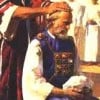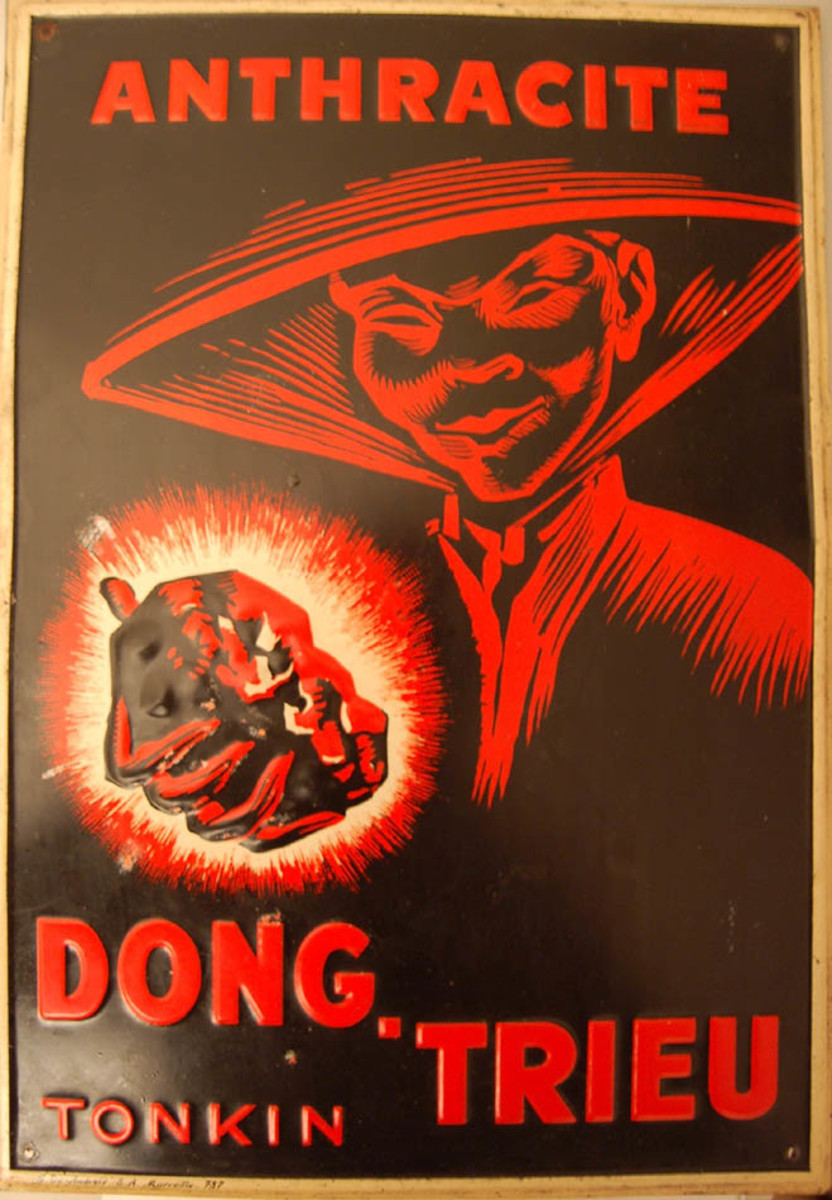The Kahana In China Part 4
With all its spread sheets, Part 3 in this series may have been a little intimidating and overwhelming when first examined. Nevertheless, it served a purpose; to demonstrate the wide spread wanderings of this particular family group. And as can be seen from the haplotype scoring of the DYS alleles, it is a distinct and unique familial grouping that was strongly connected for the past twenty-five generations. Stretching from the Indian Ocean to the Atlantic Ocean, there has to be an explanation why this family wandered the face of the earth in every direction. As I will discuss in this article, the migration does not even appear to be done as part of an ethno-migratory phase, but by members of this solitary family on its own. Obviously, this would not be what one would expect if the relocations were part of typical movements of a nomadic people, or as the result of entire communities being dislodged and exiled. If that were the case, then those new locations where J2h4h2 are located should only appear to be a drop within a bucket of numerous other Jewish or Near Eastern haplotypes that would have been part of the same migration. No, this was specifically individuals from a singular family that were able to move across borders with relative ease and not only gain prominence within the new communities they occupied but intermingle with the indigenous population to such an extent that their genetic material or haplotypes can be immediately recognized in a simple random sampling of the populace.
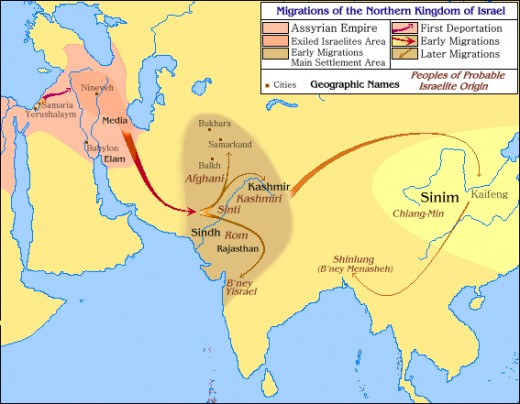
Hebrew Migration East
According to the Migration Map, the author of this particular map suggested that this migration occurred with the deportation of the Northern Kingdom following the conquest by Assyria. I think the author of the map was perhaps a little over zealous in his attribution to the eastern presence being the result of the deportations accredited to the fall of the north in the eight century BC. Though the kingdom did fall, most of the population was left in place and it was only the aristocracy and officialdom of the Kingdom of Israel that was displaced. Following their transport to Ninevah, it would definitely not have been in the Assyrians best interest to permit these highly educated and powerful captives to go wandering off on their own accord where they could ferment unrest and revolt. For the next few generations they would have seen nothing but the inside walls surrounding Ninevah and after the Babylonian conquest of Assyria, had they been allowed to migrate, it is with a certainty that they would have returned to their original homeland, not set off in the completely opposite direction.
But this still leaves us with the complicating matter that there was definitely a Hebrew migration to the Far East but it is only a matter of affixing the proper date that is crucial. Genotyping does actually help in this regard. If a migration did not occur, then it would be expected that a certain genotype will not be found at all. And if it did occur long ago in the past, for example 2700 years ago, then the intermingling with the indigenous races would have meant there would have been close to 80 generations to reproduce resulting in a significant percentage of the population carrying the genes. More recent migrations would mean less time to diffuse the genes in the population and therefore a lower percentage rate.
J2a Distribution
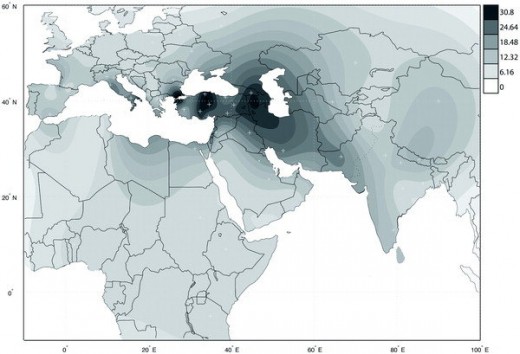
The J2a Haplogroup Distribution
According to the genetic investigations group ISOGG: "Y-DNA haplogroup J evolved in the ancient Near East and was carried into North Africa, Europe, Central Asia, Pakistan and India. J2 lineages originated in the area known as the Fertile Crescent. The main spread of J2 into the Mediterranean area is thought to have coincided with the expansion of agricultural peoples during the Neolithic period. The timing of the demographic events that brought J2 to Central Asia, Pakistan, and India is not yet known." So what they are suggesting is that it was not with the Neolithic migrations and cannot be associated with the fall of the Northern Kingdom either. And as expected, the farther one moves away from the origin of the haplotype, the lower the incidence or frequency. The frequency of Haplogroup J drops with increasing distance from its peak in the Middle East. The highest frequency is found in the Arabian Peninsula, in Yemen (87%) and Qatar (67%). The Levant region, around present day Lebanon, Israel and Iraq, has very high frequencies around 50%. The levels of Haplogroup J continue to drop in the surrounding regions. For example, Anatolia (present day Turkey) has ~40%, the Caucasus ~33%, Iran ~25% and Egypt ~25%. North Africa and East Africa also harbour significant levels (30-40%) of Haplogroup J. While Haplogroup J is found at moderate frequencies in South Europe and regions adjacent to the Mediterranean Sea (5-25%, e.g. Greece ~20%), it is infrequent in North Europe (e.g. 1-5% in UK, Germany and Russia). Haplogroup J is not observed in the Far East (e.g. 0% in China, Korea). It is likely that geographic features helped to create this distribution pattern, where deserts (e.g. the Sahara) and mountain ranges (e.g. the Himalayas) formed barriers and seas (e.g. the Mediterranean) facilitated diffusion. J2 is distinguished from J1 by a lower frequency in Arab populations and the near absence in Africa. The J2 subclade is highest in Anatolia and prominent in Mesopotamia and the Levant – all areas that served as centers of agricultural revolution. J2 is common among Turkish, Kurdish and Jewish populations and significant frequencies are found in the Caucasus, and Iran. The J2a subclade is present in Southcentral Asia (~4%), which includes India and Nepal. In India, there is a general trend for increased J2a frequency in higher castes. It has also been found in Crete (1-2%).
Of considerable note is the re-emergence of a centre of J2a in the area North of Nepal, Western China. and extending into the Mekong Delta. This does not appear to be an extension of the Indian J2a population but stands as a separate and distinct area. The significance of this finding will be discussed later in this article.
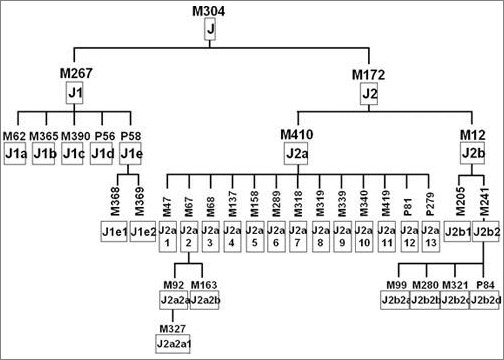
J2a4h In the Far East
Interestingly, J2a* is found as far as India and is largely confined to the upper castes. The Brahmin (priest) caste is made up almost exclusively of haplogroups R1a1, R2, and J2a (although R1a1 makes up two thirds of the lineages). It has been proposed that these 3 haplogroups have Bronze Age coalescence time and are thought to represent the gene flow of the Indo-Aryan Invasion of the Indian subcontinent about 3,500 years ago or roughly about the time of Abraham.
Distribution of Haplogroup J2a4h2
2/18 = 11.1% Cambo + Laos (Underhill et al. 2000)
1/14 = 7.1% Nav Buddha [India, West; Low caste; Indo-European] (Sengupta et al. 2006)
1/30 = 3.3% Iyengar [India, South; High caste; Dravidian] (Sengupta et al. 2006)
1/43 = 2.3% Southeastern Anatolia Region, Turkey (Cinnioglu et al. 2004)
1/83 = 1.2% Eastern Black Sea Region (AKA Pontus, NE Anatolia), Turkey
(Cinnioglu et al. 2004)
1/88 = 1.1% Pakistan + India (Underhill et al. 2000)
2/523 = 0.38% Turkey (Cinnioglu et al. 2004)
2/728 = 0.27% India (Sengupta et al. 2006)
0/23 Lasithi Prefecture, Crete (Martinez et al. 2007)
0/26 Hindus from Chitwan district, Nepal (Fornarino et
al. 2009)
0/29 Tribals from Andhra Pradesh (Fornarino et al. 2009)
0/33 North Iran (Regueiro et al. 2006)
0/41 Lasithi Plateau, Crete (Martinez et al. 2007)
0/49 Hindus from New Delhi (Fornarino et al. 2009)
0/104 Heraklion Prefecture, Crete (Martinez et al. 2007)
0/117 South Iran (Regueiro et al. 2006)
0/171 Tharu [Chitwan and Morang districts, Nepal; Low caste/Adivasi;
Indo-European] (Fornarino et al. 2009)
0/175 East Asia (Sengupta et al. 2006)
0/176 Pakistan (Sengupta et al. 2006)
As I mentioned in the previous paragraph, J2a appears to have extended into the Mekong Delta, as is evidenced by the findings in Cambodia and Laos. These are not incidental findings but findings of a significant percentage as compared to other populations in the area. Compared to the J2a findings of other regions, it is remarkably high as most of these had a zero percentage of findings. Though some of these areas may have large J haplogroup populations, these were made up of haplotypes that were everything other than J2a. And when focussing in the Far East where the haplotypes of the populace are almost guaranteed not to be J, then finding them in a small random sample as Professor Peter Underhill from Standford University did defies the odds. Explaining the significance of this finding can be compared to winning the lottery. If we look at the entire J haplogroup as if it were a deck of cards, then finding the J2a haplotype would be like pulling the Ace of Spades out of the deck on first try. But since the J haplogroup represents such an insignificant finding in general in the Far East then this deck of cards is made up of hundreds of thousands of cards with still only one Ace of Spades included in the deck. The immediate question that needs to be raised was how was this possible?
For the possible explanation we have to look at the recorded history from the ancient Cambodian Empire. The Liáng Dynasty records the story of a foreigner named Hùntián 混塡: "He came from the country Jiào 徼 after he had dreamed that his personal genie delivered a divine bow to him and directed him to embark on a large merchant junk. He proceeded in the morning to the temple, where he found a bow at the foot of the genie's tree. He then boarded a ship, which the genie caused to land in Fúnán. The queen of the country, Liǔyè 柳葉, "Willow Leaf," wanted to pillage the ship and seize it, so Hùntián shot an arrow from his divine bow which pierced through Liǔyè's ship. Frightened, she gave herself up, and Hùntián took her for his wife. But unhappy to see her naked, he folded a piece of material to make a garment through which he had pass her head. Then he governed the country and passed power on to his son, who was the founder of seven cities." Nearly the same story appeared in the Jìn shū 晉書 ("History of the Jìn Dynasty"), compiled by Fáng Xuánlíng 房玄齡 in AD 648 where only the names are changed into Hùnhuì 混湏 and Yèliǔ 葉柳. Vickery pointed out that Hùntián has only two syllables. He stated, "...it is surprising that none of the texts provided a third syllable, since, as other sinological studies have emphasized, the Chinese had great competence in systematically transcribing names from other parts of Asia, especially those in Indic languages." Additionally, it is remarkable that this story refers neither to Hùntián as a brahmin nor to Liǔyè as a nāga princess.
The points raised were that this Hùntián was a foreigner that bore a name that was not easily transliterated into the Chinese dialect. He obvioulsy had a code of modesty and wore clothing that pulled over the head rather than wrapped around the body. He had a personal deity, in this case referred to as a genie, but this deity guided him through dreams. This is a very different concept of the jinn or genies of Islam and Hinduism. In fact, this personal genie appearing in dreams has more in common with how Yahweh talked to his servants in the Tanach than it does with these other two religious versions of a supernatural being. Key to this story is that all these events happened prior to the 7th century AD. Was this Hùntián a carrier of the J2a4h2 haplotype? Was he directly related to Mar Yanqa or a descendant? Those answers are not available but as I have always stipualted, there are no coincidences.
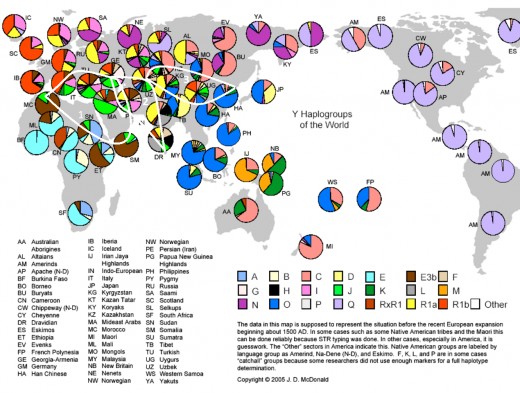
Mar Yanqa in Mongolia
In the map above, I have marked three distinct white elipses that correspond to the spread of the J haplotype across the globe. The first elipse is the one we are all aware of. The spread of the J haplotype from its Mesopotamian origins, through the Levant, then across the south of Europe and the north of Africa. And that for the longest time is what we knew of Jewish migratory patterns. Since this map represents the human haplogroup distrubution as it appeared prior to 1500 then the second elipse showing the presence of the haplotype throughout the Arabian peninsula, Persia and then into India corresponds to what we know of the Arab migrations along with the spread of Jewish communities through the Arab world. But the third elipse, which appears disjointed from the other two, is something that was not anticipated through any migratory pathways recorded in history. Had it simply been a case of Arab/Jewish travellers and merchants moving along the Silk Road, then the pattern would have suggested decreasing concentrations of the haplotype the further east one travels from Persia. But instead we have a heavier concentration within Inner Mongolia with arms that decrease as one travelled east or west from this point. This would suggest that Inner Mongolia was the cradle of this particular migratory pattern and not directly connected with the two other areas demarcated in elipses 1 and 2.
From a scientific standpoint, there may be significant proof of the legend being more of a reality than a myth. With the haplotyping of the likely DNA sequence for Genghis Khan derived from his proposed descendants there were several anomalies that distinguished him from the general Mongolian population. This variation in particular concerned the number of alleles for DYS markers 391, 392, 426, 455 and 459a. When compared to the Khallach, the predominant Mongolian ethnic population it becomes obvious that the sequences for these genes came from a completely different ethnic group. Examining 17 different Mongolian populations the allele number for DYS391 was 9 for all of them. Ghenghis Khan’s descendants were 10 as coincidentally were my J2a4h family. For DYS 392, only the Japanese were consistently 11 like the Khan’s but we know he was not of Japanese stock. In general Mongolian alleles number 10 for DYS 392. Again, my relatives were also 11 like that of the Khan. DYS428 is known as having the lowest mutational rate at 0.00009, so what it records as now was probably what it has always been since the dawn of time and for the Khan that number is 11, again identical to my J2a4h family. DYS455 has a similar low mutation rate at 0.00016 and again for both the Khan and my family the number of alleles is 11. Then lastly we look at DYS459a, the number of alleles commonly being 9 for Mongolian populations but once again the Khan’s family and mine are in agreement at 8. Though none of this will actually prove beyond a doubt that the Glittering Man was a descendant of my family, it does demonstrate that Genghis Khan did have an ancestor that was outside the general genetic pool of Mongolia and whereas my haplogroup is J2 and his is C, with agreement of five markers that have key qualities, the possibility of the legend being true is given at least some credence. But since Y haplotypes are supposedly inherited, then through a male descent there is no way that Genghis Khan with his C grouping could have been a direct descendant through the male line. Which immediately raises the question then how can you account for the five similarities, two which natural mutation are ruled out for, existing without a direct male to male descendancy? A good question but one that can possibly be accounted for with the translocation of genetic material into female descendants that would then pass on some of the genetic material but only a small percentage of the total number of alleles. How this occurs is through a process called chromatid exchange. Outside the pseudoautosomal regions, the mammalian sex chromosomes are thought to have been genetically isolated for up to 350 million years. However, in humans pathogenic XY translocations occur in XY-homologous (gametologous) regions, causing characteristics such as sex-reversal and infertility. Gene conversion might accompany recombination intermediates that resolve without translocation and persist in the population. Researchers found a translocation hotspot adjacent to the PRKX and PRKY genes and found evidence of historical exchange between the male-specific region of the human Y and the X in patchy flanking gene-conversion tracts on both chromosomes. The rate of X-to-Y conversion (per base per generation) is four to five orders of magnitude more rapid than the rate of Y-chromosomal base-substitution mutation, and given assumptions about the recombination history of the X locus, tract lengths have an overall average length of ∼100 bp. Sequence exchange outside the pseudoautosomal regions could play a role in protecting the Y-linked copies of gametologous genes from degeneration. Translation, it basically says it was possible that a female ancestor of Genghis Kahn who in turn was a descendant of Mar Yanqa, could have passed on some of the alleles that we find are identical between the two families even though Mar Yanqa was a J haplotype and the Mongol conqueror was a C haplotype.
In Conclusion
But enough of the heavy scientific jargon and more an issue of simple faith. This journey that has taken me from the shores of the Near East to the far reaches of China is far from over. What started as folklore handed down by one of the family patriarchs has now become a plausible historical event that warrants further investigation. I've looked at the corresponding legends from the Far East and the Princess Ti-Ping, or Sheping as she may have been known, was a real person and daughter of an Emperor who reigned at the time it was recorded that one such Chinese ruler sent his daughter west as part of an alliance with a King of Khoton. The Glittering Man? Well, perhaps we may never know who he really was but the possibility that he was Mar Yanqa cannot be dismissed. As I head back to China this week, I know that there is far more that I have to research and many more texts and places that have to be examined. But with time, all things will be revealed.
Avrom Aryeh-Zuk Kahana
